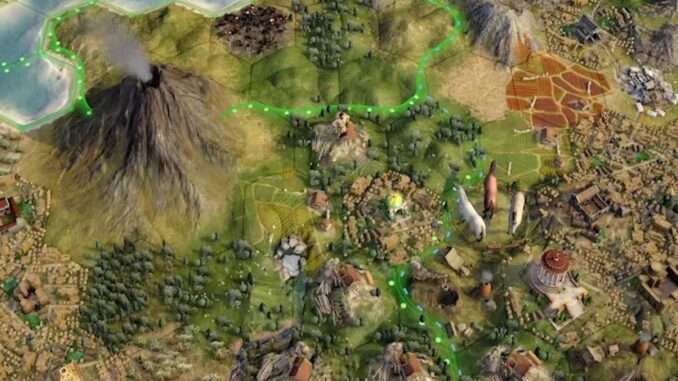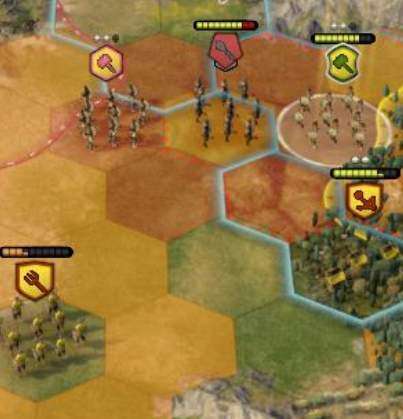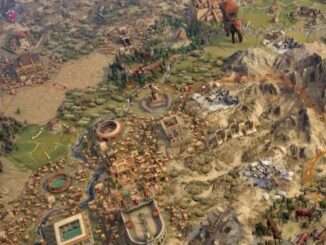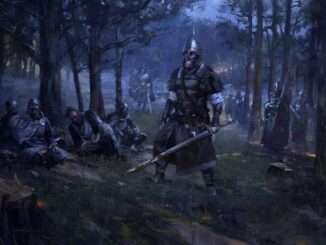
Definitive Guide to Combat
The Basics
The whole point of OW is to establish and grow a Kingdom in a world where Kingdoms already exist. At the founding of your first city, on Noble level, you will be behind (and you’ll be even farther behind if you increase the difficulty from there). You’ll have to catch up, and ultimately surpass your rivals if you want to win. That means that sooner or later, you’ll have to fight.
You’ll either fight barbarian hordes that invade your lands, or you’ll fight them for space to expand into, or, if you decide not to expand, sooner or later, you’ll fight a much larger AI Nation who has decided to come take what’s yours. Battle is an important part of growing your realm, so even if you’re a pacifist builder by nature, get used to fighting in OW, because you’ll have to. Sooner or later, you’ll have to.
The very first point to make about combat in Old World is to draw your attention to a key difference between combat here and combat in most other games in the genre:
There is no “counterattack.” You attack on your turn, and the AI attacks on its turn.
Well, that’s not 100% true. There is a very limited form of counterattack and you’ll see it when melee units clash, because they’ll take a nominal amount of damage (1hp) in retaliation for a melee attack.
Also, units that have the “rout” ability can take a bit more damage on the counterattack (max of 2hp, but in neither case above will the damage ever kill the attacking unit).
Effectively then, there is no “counterattack” here, and that will take a bit of getting used to if you’re coming from some other 4x game.
Another crucial difference is the fact that hills don’t provide an intrinsic defensive bonus (nor do trees, for that matter).
Instead, hills allow you to get off of the flats, escaping from a cavalry unit’s “+25% bonus vs. infantry units on flat terrain” ability. Hills then, are still useful, but not in the same way that they are in many other games.
Similarly, although trees don’t provide an intrinsic defensive bonus, they do reduce incoming missile troop damage by 50%, which is incredibly valuable.
Perhaps though, the best way to explain terrain advantages and disadvantages would be in summary form so:
- Flat tiles (Cavalry units get a +25% bonus to infantry units caught in the open).
- Hills: Extend the range of all missile troops by +1, unless their target is also on a hill.
- Forests: Reduces damage dealt by enemy ranged troops by 50%.
- Scrubland: Reduces damage dealt by enemy ranged troops by 25%.
- Urban tiles: Provide a 25% defensive bonus to infantry units (which includes both melee and
ranged units). - Cross-river attacks are 50% less effective for melee and cavalry units (ranged units suffer no
such penalty, naturally).
** Note that some urban improvements (Garrison, Stronghold, Citadel) provide defensive bonuses.
These stack with the urban tile’s 25%, so for instance, if you put a spearman on a Garrison, he’ll get the 25% for being on an urban tile, plus the 20% defensive bonus for being on the Garrison tile, and if he has also taken Guard/Combat/Garrison promotions, those all stack too, which means you can create a devastatingly effective defensive unit with the right combination of factors.
Naturally, this works offensively as well. Putting “Besieger” and “Garrison” on the same unit will give that unit both bonuses if you’re attacking into an urban tile FROM an urban tile. Add Strike and Combat to that for an even bigger punch and you’ve got yourself a unit killing machine.
In addition to that, consider your generals and where to place them carefully. A unit with Focus III, paired with a high Wisdom general who radically increases the % chance of scoring a critical hit (double damage) is devastatingly effective.
Strategy Notes on Combat in General
In most other 4x games, putting your kingdom “on a war footing” usually meant assigning every city to building troops.
For me, in Old World, it means almost the exact opposite.
I’ll have 1-2 of my best cities (those that can train the troops I need most quickly) training reinforcements, but everybody else that I can afford to will be assigned to training specialists.
Why? Because odds are good that I won’t be able to assign jobs to any of my workers while I’m engaged in battle. With specialists training though, I can still grow my economy, especially if I’m focused heavily on rural specialists that increase my basic resource outputs.
A general with 6-8 points of courage added to a Maceman or Swordsman, especially if you’ve given him attack-oriented promotions, can create a unit that can one-shot almost anything.
Also, be aware that some leader archetypes allow you to do amazing things in the field. The Tactician ruler/general for instance, can “stun” the unit he attacks, effectively taking it out of the fight the following turn. The Hero can “Launch Offensive” by spending 600 Training, which allows the general’s unit and every unit you control adjacent to it to move and attack again that same turn (orders permitting, of course).
The bottom line is that promotions and generals add a whole new dimension to combat that’s well worth taking the time to study.
There’s no one “right” answer where that is concerned, so you’ll want to experiment to find the promotions that work best for you and your play style, then pair your best troops with your best generals for maximum effect.
Note: The damage formula is as follows: (Attacker/Defender) * 6
Damage may never be less than 1 point and fractions are rounded up in favor of the stronger unit.
Strategy Notes on Generals & Promotions
Personally, I prefer force preservations promotions over those that increase my attack strength. I usually bring enough troops with me that I can kill the units I need to kill.
What I have relatively less control over, however, is what the AI does on its turn, and for that reason, I place a premium on Guard and Combat promotions, which provide a defensive edge on the enemy turn.
For ranged troops, my personal favorite is Eagle Eye/Marksman, because I like being able to outrange my opponent and hit without being hit back.
I’m also rather fond of putting Hero leader/generals in charge of Onagers or Cimmerian Archers (units that deal ranged, splash damage). Being able to use a cluster of such units twice on the same turn is simply devastating.
Combat Basics & Army Organization
Combat tends to be fairly orders intensive. As such, if you have a big fight on your hands, you’ll probably want to make sure you address it first, so you’re not stuck with too few orders to actually command your army and either execute an attack, or properly defend your holdings.
One of the hidden advantages of Ranged units then, is that they generally don’t require quite as many orders to use (since they don’t have to be right next to a unit to do it harm). Use that to your advantage whenever possible and try to avoid having too many irons in the fire at one time. If you’re fighting on multiple fronts, you’ll exhaust your supply of orders very quickly.
Also, for the most part, don’t try to issue orders to workers if you’re engaged in a serious fight, or if you do, then wait until after you’ve issued combat orders and moved any reinforcements that you need to move. Then, if you’ve got a stray order or two, by all means, give a couple workers something to do.
In addition to understanding the importance of tactical maneuvering and terrain, it’s also important to understand the basic relationship that different troop types have with each other, so be sure to study the bullet points on terrain until you intuitively understand the benefits of each.
In my games, ranged units do most of the heavy lifting. Infantry units are meat shields who stand in front of and protect my ranged units, dig enemy units out of forests, and actually attack/occupy cities. That’s their job and they take promotions that make them better at those things.
Spears are deadly to cavalry. Cavalry are deadly to siege engines and anything caught in the plains.
They’re also fight finishers, since they have the “rout” ability, which gives them multiple attacks, assuming their initial attack was a kill.
Axemen are deadly to spears. Elephants are combat specialists, used to force an enemy unit off of a highly defensible tile so it’s easier to kill him. Macemen are deadly to infantry units in general and Swordsmen are deadly to, well…everything.
Don’t forget that you can rename any unit (or any character, for that matter) in the game, so if you’re worried about having to micromanage your army, don’t. The renaming feature makes it easy to find the units that you’re looking for.
I’m in the habit of renaming any units that have the “Besieger” promotion to “Siege Crew.” Then, when I need to attack a city, I can go to my military summary screen and find the best units for that job, very quickly.
You can use that same basic paradigm to organize your army to make it easy to put your hands on whatever configuration of units you need to address the current military threat.
Tactical Considerations
Aside from terrain, there are a few additional tactical considerations you’ll want to be constantly aware of. These include:
Zone of Control
Most combat units exert ZOC, which limits a unit’s options on if or where it can move in relation to your units.
As with most things, mass matters. A single unit exerting ZOC in a one tile radius isn’t all that interesting or powerful.
A whole line of units, however, can exert ZOC over a massive area and really shut down an enemy’s options.
…except when it can’t of course. Cavalry units (and some unique units) can ignore ZOC (unless it is exerted by a Spearman or Pikeman), so while it’s a powerful tool in your arsenal, there are counters to it, and then there are counters to the counter, which makes combat both dynamic and exciting.
Final note about ZOC: You can use your units’ ZOC to cut enemy cities off from trade routes. This is true of blockading ships and strategically placed land units on road tiles. This doesn’t cause much damage but it does cause some and it increases discontent in the city impacted, so…
Adjacency Bonuses
Some units (this will be shown in the unit popup when you click it) gain a bonus for being adjacent to another unit of the same type. In addition to that, some generals provide attack/defense bonuses if they’re adjacent to units of the same type. Watch for these and use them opportunistically to give yourself a combat edge.
Splash (And Related) Damage
Some units deal damage to the unit they target and some or all units adjacent to it. Onagers, for example, deal full damage to your target, and 25% “splash” damage to every enemy unit adjacent to the unit you targeted. Akkadian and Cimmerian archers do this too (the Babylonian Unique Units).
Axemen will deal full damage to the unit you target, and partial damage (25%) to enemy units adjacent to both it and the axeman.
Spears will do full damage to the unit they target, and if there’s an enemy unit directly behind the target, that unit will take some damage too.
These extra bits of damage can add up very quickly and if you plan your attacks carefully, you can devastate large numbers of enemy units with ease.
Finally, be aware that some leader/generals have incredibly powerful special abilities. Stunning an enemy unit is a battlefield changer, and “Launch Offensive” is a game-ending ability you will want to take full advantage of any chance you get!
Flanking
One final note on this section must be about the importance of flanking. In Old World, a unit is considered flanked if you have a unit on opposite sides of it (so for example, if you’re attacking a unit and you’ve got your own units on tiles due east and due west of that unit, it is considered flanked.
You get an attack bonus when flanking, if you are using a general with the Commander archetype who is also your current ruler.
That, however, is not the main value of flank.
The main value is ZOC-Lock.
Every unit in the game exerts a Zone of Control that extends in a one-tile radius around it.
Zone of Control says that an enemy unit can’t move from a ZOC tile and into another ZOC tile (unless it has the special ability “Ignore ZOC,” which is found on mounted units and the Roman Unique Unit).
A unit that has been ZOC-Locked cannot move. It’s pinned down and you can kill it at your leisure. Want to prevent a barbarian raider from rampaging through your territory, destroying improvements? Flank it.
Want to prevent that onager from getting away until you can get a unit over to kill it? Flank it. Even better, if you can push the tide of the battle away from the flanked onager, that unit is utterly powerless, since it cannot fire at point blank range (onagers can only fire at units 2, 3, or 4 tiles away – 5 if they’re on a hill).
Flanking units allow you to do more with less. In a large battle, you can selectively ignore the enemy’s fore-ranking troops, killing some, flanking the remainder and attack more deeply into the enemy’s lines.

The Persian Mace in the image above is flanked. He cannot escape the ZOC of the Assyrian units without assistance.
Rout
Some units (mostly cavalry) have the “rout” ability. This enables them to attack again (orders permitting) if their first attack kills the unit they hit. That’s huge. If you pair cavalry with units that can damage multiple opponents (onagers, Akkadians, Cimmerians, axemen, etc.), then you can use those units to weaken a group of attackers and send a unit with “Rout” in to finish the whole batch off. Absolutely deadly.
Fortification
One of the best and easiest ways to get a defensive bonus for infantry units.
It costs an order to initiate, but every turn your infantry unit does not move, he gets a +5% defensive bonus (to a max of 25%). Note that you can still attack, you just can’t do anything that would cause you to leave the tile or you lose the fortification status and any bonus you may have accumulated.
Pillage and Burn
These are two options that don’t get used very often because in practice, at least most of the time, if you are attacking a rival’s city, your goal is to capture it for yourself, so pillaging tiles that will soon belong to you is of limited value.
That said, there are specific instances when this can be useful. For example, if you and an allied nation are attacking a city and your ally captures it, you can pillage tiles inside the captured city’s borders before it officially “flips” to your rival, and doing so will net you some resources. It might not be much, but it’s a decent consolation prize if you fail to take control of the city.
Another example would be if you have devastated the rival nation’s army and his Kingdom lies defenseless before you but for whatever reason, you want to leave the Kingdom alive but hobbled, continue advancing into the enemy Realm and strip it bare before agreeing to a Truce.
Your rival still lives but will be forever hobbled (because you’ve killed all his workers too, so he won’t be able to repair the damage). It will be decades before that rival is in any shape to threaten you again, and you gain a large windfall of resources.
The drawback here is that it’s tedious, micromanagement style work and you’ll probably get bored with it before very long.
Note that while Pillage and Burn accomplish more or less the same thing, they do so in slightly different ways. For one thing, Burn doesn’t give you any pillage resources. It simply destroys the improvement in question.
For another, Pillage costs and order and ends the pillaging unit’s turn. Burn costs 100 training but doesn’t end the burning unit’s turn. Both have their uses but they are highly situational. Even so, it’s important to know that they exist so you can make use of them if and when the situation calls for it!
Battling The Barbarians
Fighting the barbarians not associated with one of the major tribes is generally pretty straightforward. You drive up, beat the “stray” barbarians to death, ganging up on them to kill them quickly if you have more than one unit at your disposal, and then, you pound the defenders inside the camp to death, being sure to leave one of your troops on the site of the camp so you can build a city there.
Note: If you don’t keep it occupied, one of two things will happen. It will either morph back into a barbarian camp in ten turns, or far more likely, one of your rival Nations will come and park a guy on it, then build a city there.
It’s entirely possible to take out a barbarian encampment with just a warrior or a slinger, though if they get reinforcements (spawn more barbarians) you could find yourself in over your head and have to pull back, heal, and possibly reinforce, then try again. In fact, if you go at it early enough, and you’ve got terrain on your side, you can even take out a barbarian encampment with nothing but a slinger, but that can be risky, for sure.
That’s it in a nutshell, but of course, there are nuances. Taking the high ground for additional range (slinger) or taking to trees for defensive bonuses against ranged attackers is always a good idea (and best of all, a hill with trees on it)! Not attacking from across a river unless you’ve got the Engineer upgrade that makes such attacks a good idea…that kind of thing, but those are all pretty standard to this type of game and most people will be instinctively familiar with those types of tactical maneuvers.
It’s slightly more complicated to tangle with a barbarian camp that’s associated with one of the major tribes because often, their camps are clustered together, and maneuvering becomes more important. You don’t want to stray too close to the next Numidian (or whomever) camp and risk activating the units surrounding it, so more care has to be taken when fighting those barbarians, but it’s essentially the same process.
Strategy Notes on Barbarian Camps
The combat-oriented Nations like Assyria and Rome can typically just walk up and curb stomp a barbarian camp in the early game. Lots of Nations, however, can’t, and if you’re struggling to capture early game camps, you can make your life easier by using your scouts and/or settlers offensively.
Using scouts offensively amounts to using them as meat shields and letting them take a hit or two, rather than letting the barbarians attack your starting military unit.
Once you capture a barbarian camp, if there are surviving barbarians in the area that can still attack you, then you may need the help of a settler.
Use your settler offensively by rushing him toward the barbarian camp site and found your new city mid-battle. The barbarian’s attack will fall mostly on the city’s defenses and he won’t be able to take the last HP from your military unit he knocks the city’s defenses down, which he’ll never be able to do, because you’ll kill him long before then.
Sure, you’ll suffer a bit of additional discontent, but it’s not enough to really matter in the long run, and it makes capturing the site a whole lot easier.
This matters because you want to start taking barbarian camps over as soon as possible. For the most part, the AI will leave your “freebie” sites alone, so you can backfill those when it’s convenient, but if you wait to start taking camps, then you may find yourself with relatively few to choose from.
Quick Note – Attacking Cities
Cities are surprisingly tough customers. A city with no walls has 10 hp, but your early attack units will, at best, only do a point or two of damage when attacking the city.
If the city in question has a garrison inside it, that unit will only take incidental damage so long as the city’s defenses hold and you literally cannot take that unit’s last hp while the city’s defenses remain even partially intact.
In other words, to capture a city, you’ll need to knock down its defenses, then kill the military unit inside it (if any) then kill the civilian unit (worker, disciple, settler) inside it (if any) and THEN you’ll be able to occupy the city and begin its capture. The capture process takes 1 turn per culture level of the city on the turn of capture.
Battling The AI Nations
Fighting the AI Nations tends to be a fair bit more complicated than battling with tribes over expansion sites.
For one thing, cities are much harder to take out than barbarian camps are, so you can bet that it will take longer unless you’ve brought simply overwhelming forces with you.
For another, the AI for Nations is programmed to be much more effective than the barbarian AI. You can feel the difference when you’re fighting them. The barbarians don’t retreat, for example. They’ll ust stand there trading blows with you until one of you dies. The AI Nations won’t do that. If you damage but don’t kill an AI Nation unit, he’ll run away and heal, then come back to try and kill you later, and of course, the AI Nations really don’t like it when you attack their cities, and they’ll do everything they can to keep you from doing that, which usually means sending troops in to beat up on your siege crew.
That puts you in a bit of a pickle. Do you keep pounding on the city or do you stop doing that to deal with the enemy troops? The optimal answer is: bring enough guys to the party so you can do both, but that’s not always practical.
If you can’t do that, then the best answer is: army first, city later, because after all, the city isn’t going anywhere, and taking it from the AI will be a lot easier once you relieve him of his army.
The absolute minimum size for an assault force against an AI Nation I am comfortable using is 12 units, generally comprised of: 2 siege engines, 4 archers, 2 chariots, and 4 infantry (usually 2 spears and 2 axemen).
But that doesn’t leave you much in the way of padding, so I generally go with 15+ units, adding more infantry so I can rotate out the wounded and heal them up behind the lines.
Strategy Notes on Battling AI Nations
Force preservation creates turn advantage.
Bring enough troops with you so that you can establish a rolling line, and whenever possible, pull your wounded to the back ranks to give them a chance to heal. If you can “recycle” your wounded troops, and you deny your opponent the chance to do the same, his build queues will be filled with replacements, while yours will be filled with reinforcements. That’s a huge difference.
This is why (for me) Guard and Combat promotions are so important. You have finegrained control over what happens to your troops during your turn. You have almost no control during the AI’s turn. Guard/Combat gives you a bit of an insurance policy, and that can be critical.
Also, “Lures” can be spectacularly good ways to demolish large portions of the enemy force because the AI likes to dogpile units (you should too – in general, don’t attack something unless you’re pretty sure you can kill it on the same turn – don’t let enemy wounded get away)! So, send one sacrificial unit (militia are good for this) out ahead of your army, he gets dogpiled, and you lose 1 unit. Then you crush the 4-5 enemy units that attacked him on your turn.
That’s a good trade (note: AI is getting better at not falling for this, but it still sometimes works!) Chariots/Horsemen are magnificent at finishing fights! Archers and infantry cripple 3-4 (or more) enemy units. A single chariot swoops in and utterly destroys the lot. Brutally effective.
Finally, splash damage is your friend, especially if you have a unit that can rout waiting in the wings. Onagers, Axemen, Swordsmen – you want as many of those types of units as you can get (which is why the Babylonian Unique Unit is so powerful!). With enough of those types of units massed, you can simply cause an enemy force to evaporate.
Here are some good general guidelines when planning to attack a rival nation:
- Make sure your vassal families are happy! Nothing is more important than this. You don’t want to go to war and have to keep looking over your shoulder. If the families aren’t happy, or at least neutral toward you, then you’re not ready to project your power.
- Never attack blindly. Eyes up. That means scouting, or even better, the infiltration of as many of your target’s cities as you can manage.
- If your opponent has better tech than you (“learned” or above on the game screen), make sure your opponent is “much weaker” before you attack. If you’re comparable (the AI shows as “competent” on the game screen), then make sure your opponent is “weaker” militarily before you attack.
- If you’re “similar” in both strength and tech, then you need to use diplomacy as a sword. Make friends with someone else who shares a border with your rival and get that Nation to declare. Wait a few turns for your target to move his army toward that enemy, then strike.
- If at all possible, run as many espionage missions as you can afford in the 1-2 turns leading up to your invasion to sow chaos and weaken defenses.
In an ideal world, you’ll stack as many of these advantages in your favor as possible before you declare war, but of course, you seldom have the luxury of achieving the ideal, so…just stack as many of the items above in your favor, be smart when it comes to tactical maneuvering and positioning, use the special abilities of your generals to their fullest extent, and in most cases, you will prevail!





Be the first to comment